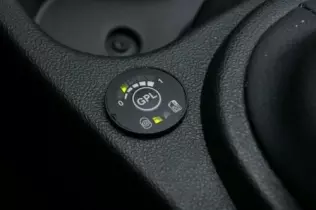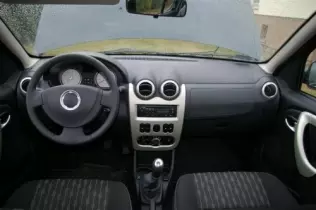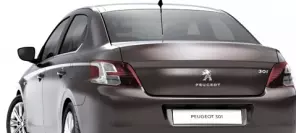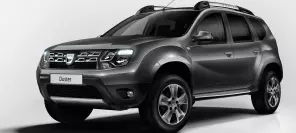- Main page
- Search
- Up to date
- Products
- Technology
- Vehicles
- Video
- Conversion Payback Simulator
Port Injection - Conversion Payback Simulator
Direct Injection - Conversion Payback Simulator
Diesel - Newsletter
Dacia Sandero LPG - a modernist car
- Home page
- Up to date
- Reportages, interviews, road tests
- Road tests
- Dacia Sandero LPG - a modernist car
« Powrót
 loading results...
loading results...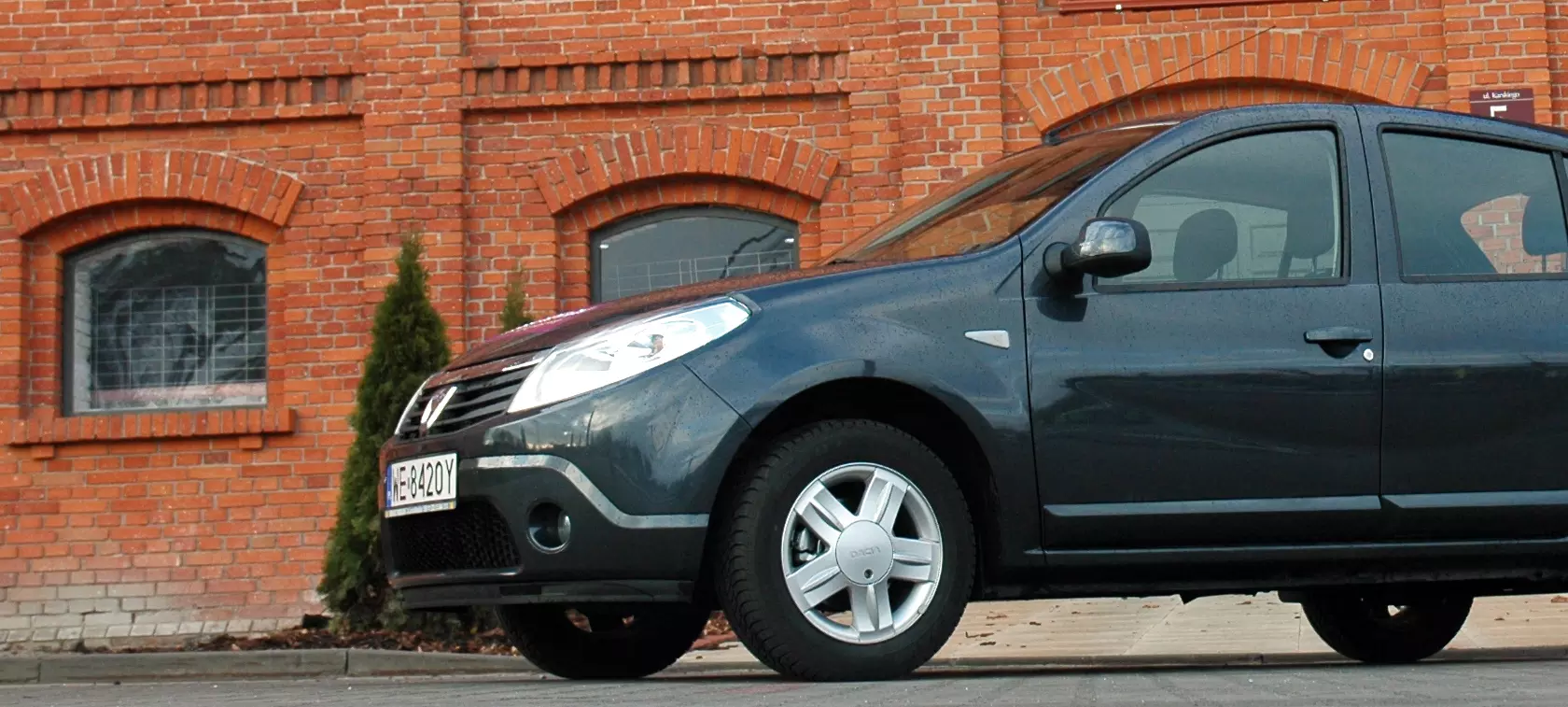 © gazeo.pl
© gazeo.pl 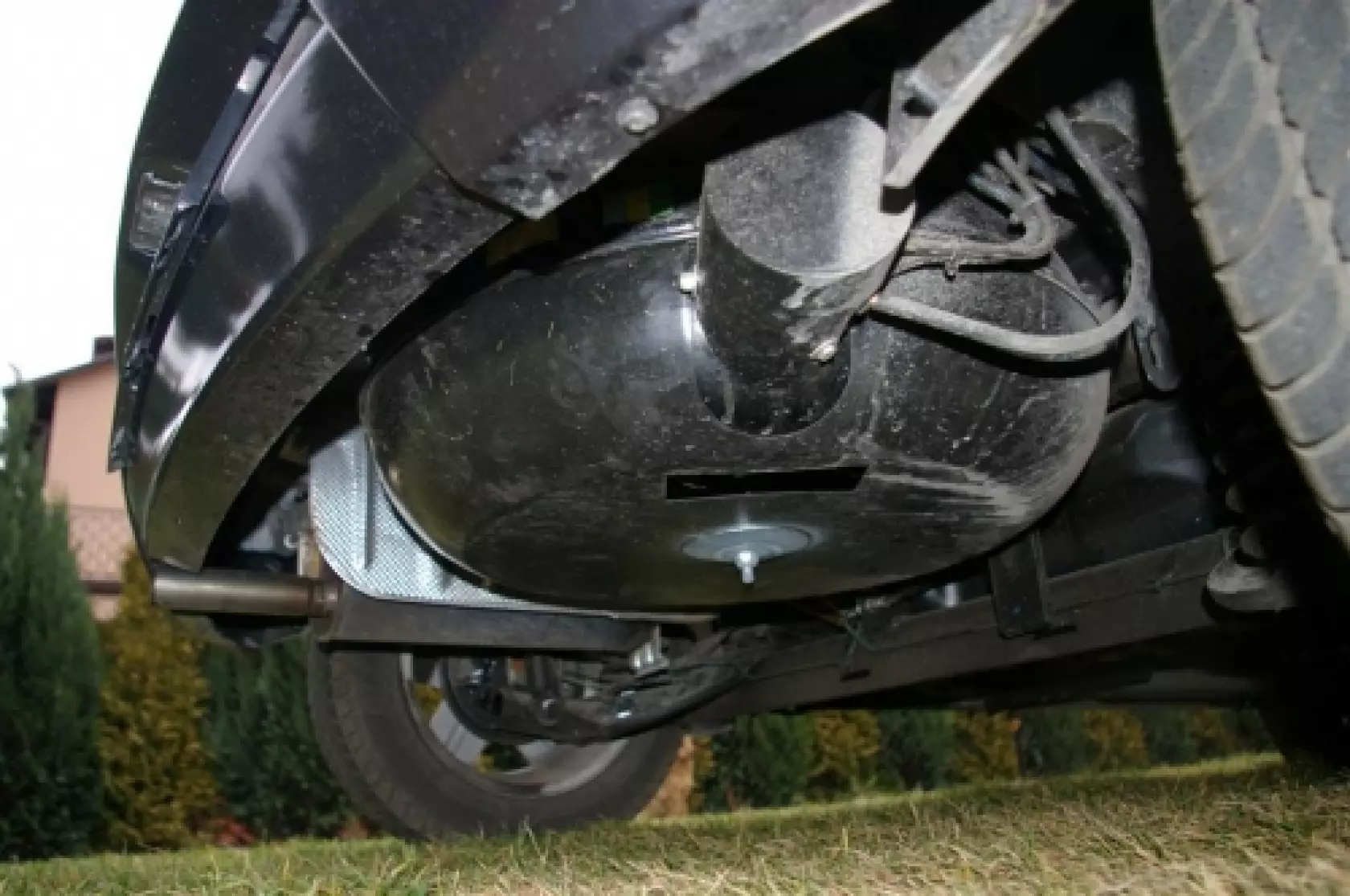 Placing the spare wheel (replaced by the LPG tank here) beneath the body is typical of French cars and the Sandero is one in a way
Placing the spare wheel (replaced by the LPG tank here) beneath the body is typical of French cars and the Sandero is one in a way 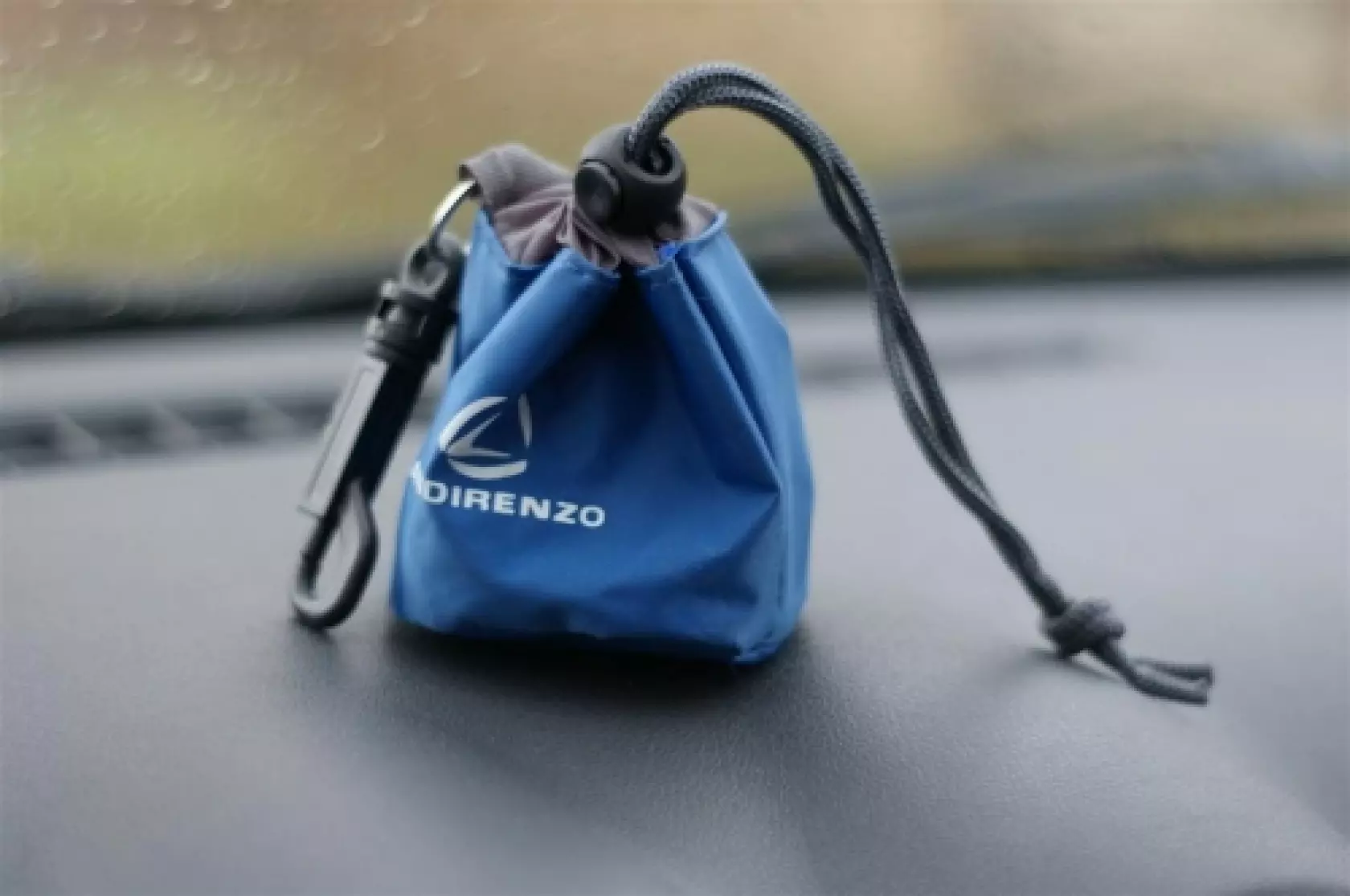 The filling adapter is stored in a small bag which helps contain the smell of gas
The filling adapter is stored in a small bag which helps contain the smell of gas 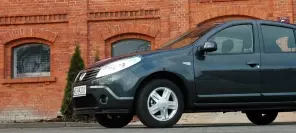


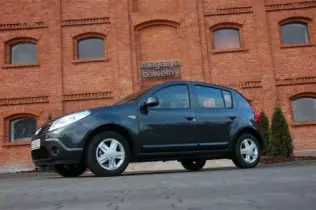 © gazeo.comCompared to the Logan, the Sandero looks flamboyant, but in reality does not stand out from traffic
© gazeo.comCompared to the Logan, the Sandero looks flamboyant, but in reality does not stand out from trafficIf you decide to buy a Dacia, what you see is what you get – not a badge pinned to the grill, not a few decades of tradition and innovation, but exactly what you pay for: body, wheels (plus a steering one), engine and seats, backed up by proven technology and decently put together. In other words, all the essentials and nothing more. Fair enough, because many consider a car not an emotion-evoking, desirable subject of dreams, but merely a utility object designed to move between points A and B. The Sandero has been made for doing just that and given it has an LPG system on board, it does its job perfectly.
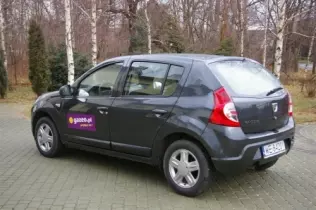 © gazeo.comTail lights are all the extravagance you will find on the Sandero, but for a reason - simple things are cheaper to make
© gazeo.comTail lights are all the extravagance you will find on the Sandero, but for a reason - simple things are cheaper to makeOf course, one could argue that from a technological viewpoint, the Romanian supermini is the missing link between its Renault mothership and a museum. The Sandero has no direct-injected engine or a whole range of electronic assisting systems, but its simplicity is actually a virtue – the car is cheap to design (many components just wait ready to be taken off the shelves from Renault's warehouses), build (good command of manufacturing processes) and repair (non-complicated mechanics), plus – thanks to the optional autogas system – cheap to maintain. If you do not mind hard-as-a-rock plastic on the dashboard or ergonomy typical of German models, you will be satisfied. Oh, you will also need to lose the habit of overtaking dynamically, but let us leave that for a moment.
We are going to begin with a bit of comparison instead. A Sandero 1,2, the basis for our test car, is priced at 29900 zlotys (approx. 7300 euros by today's exchange rates) in its entry-level Access trim. The entry-level Renault Clio Authentique with the same engine, which is the technology donor for Dacia's counterpart, is priced at 35950 zlotys (8750 euros).
The cheapest LPG Sandero, also equipped with the 1,2-litre four-pot, costs 38700 zlotys (approx. 9400 euros), but not because the autogas system is priced at a hefty 8800 zlotys (2100 euros) – the trick is that the LPG option is only available from the Arctica version up. All in all, it only takes 3900 zlotys (950 euros) to have the car converted to run on half-priced fuel. This means you get a decently equipped Sandero for less than 3000 zlotys (730 euros) more you would have to spend on a bare Clio. You might think the difference in quality would be visible, but not so much – in the supermini segment, unless you go for the more upscale models such as Mini, Audi A1 or Citroën DS3, the level of quality (both in terms of materials used and assembly precision) is relatively even. You pay for the brand, really.Truth be told, it comes easier to tolerate bare screw heads in the cabin of a 40 thousand zloty (sub-10 thousand euro) car than in the cabin of that priced at 45-50 thousand zlotys (11-12 thousand euros), aspiring to be seen as premium. Compared to the disastrously made Dacias from the 1970's, 80's and 90's, technologically stemming from the stone age, the Sandero is one hell of a good car anyway.
All right, so let us now fulfil our previous announcement and comment on the Sandero's talent for driving. We are not going to be particularly enthusiastic about it, though. While it would be out of place to complain about comfort, suspension or steering (given the car's price), it is perfectly in place to make a statement about the engine's lack of vitality. The power (75 HP on petrol, 72 HP on LPG) proves sufficient in terms of reaching any speed legal on Polish roads (provided you get a pair of earplugs as it gets loud above 100 km/h), but the modest torque value (107/103 Nm on petrol/gas respectively) and gear box characteristics make overtaking a greater adventure than a safari in the heart of Africa or escaping a blood-thirsty tiger in a Borneo jungle. Without reducing gear to the 3rd and pushing the pedal to the metal, it is definitely safer to remain in your lane, unless you get your ya-ya's out by confronting juggernauts and coaches eye-to-eye.
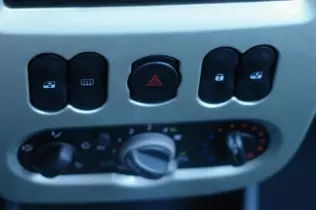 © gazeo.comOperating power windows from the dashboard is acceptable, setting the A/C from this place - hardly so
© gazeo.comOperating power windows from the dashboard is acceptable, setting the A/C from this place - hardly soThe engine's relatively low displacement has a bright side, though – moderate fuel consumption. Cruising the interstate at 80-90 km/h will cost you less than 8 l/100 km (which is still 1,5 l/100 km more than Dacia promises), accelerating to and maintaining highway speeds (140-150 km/h) equals to just below 10 l/100 km. It is quite hard to estimate consumption properly, since the test vehicle, decently equipped as it was, had no trip computer. At first it struck us as impossible, because such an option would seem obvious on any modern car, yet it is a fact. Anyway, filling up with LPG (Dacia says the tank holds 34 litres, we managed to squeeze 35,16 litres in) is good for at least 400 km of range, maybe even 440 km. That means you get an affordable car – yes, it is crude, but how many people need a Rolls-Royce? – consuming acceptable amounts of the most affordable fuel there is today. Is this the ultimate car? Unless you expect too much of it – it sure is.
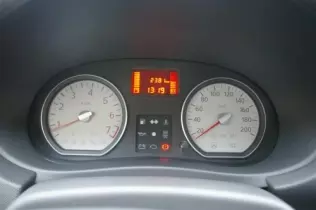 © gazeo.comThe meters are clear and visible, unlike the controls between them, difficult to decipher in direct sunlight
© gazeo.comThe meters are clear and visible, unlike the controls between them, difficult to decipher in direct sunlightWe decided to check if the Sandero's practical features fit its „optimal” image. Since it is a supermini, obviously you will not find the rear seats as comfortable as those of a luxury sedan or more space than necessary, but there is just enough room. Unless you are a basketballer or a sumo wrestler or either of them sits in front of you. The boot is a nice surprise – replacing the spare wheel with a tyre saver kit means the 320 l capacity is fully usable. And it is quite a boot, too – the Kia Rio, though newer, has only 288 l of space beneath the rear hatch. If you buy a small car with transporting larger objects in mind – exotic animals' stuffed heads, a hunted boar, contraband, your mother-in-law's hats and such like – you may fold the back seats and get a 1200 l capacity. Just remember the maximum load is 480 kg. In case of emergency, a trailer is an option. If it has its own brakes, it may weigh up to 1050 kg, if not – no more than 570 kg.
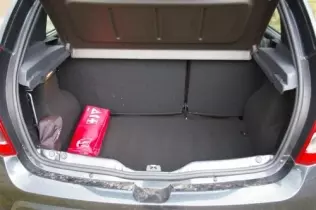 © gazeo.comThe Sandero as a gangster car: the boot will house a body and a spade, while the blunt looks will help you get out of town unnoticed
© gazeo.comThe Sandero as a gangster car: the boot will house a body and a spade, while the blunt looks will help you get out of town unnoticedTime to judge. If you are looking for avantgarde, innovation and something for the senses to feed on, you have wasted a part of your life reading this test. Well, hard luck! But should you be seeking a car that is simple, anonymous to the point of being dull, deprived of all emotions (except when you overtake) and worth every penny spent on it, run to the nearest Dacia dealer and get yourself a Sandero. If, after all, you choose to make a statement with your Dacia, you have the quasi-pseudo-off-road Stepway version at your disposal, and if you are ready to sacrifice a little more money to get some extra performance in return, there is an 8-valve 1,6 l engine available. It pumps 84 HP and 135 Nm (82 HP and 131 Nm on LPG) and, while still not a speed demon, makes driving less of a courage and patience test. In our humble opinion, the Romanian brand's models have a more attractive price-to-value ratio these days than Skoda, which itself has apparently become tired of being Volkswagen's poor cousin and started moving upscale. Dacia promises it is going to remain faithful to its "budget-car-maker” roots and will always make good, yet cheap cars. And as the Lodgy van proves, they will be prettier by the model. We say yes!
You may also find these interesting:
 loading results...
loading results...
